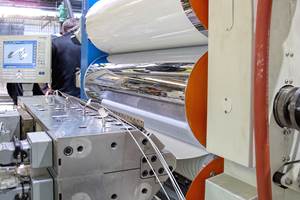‘General Purpose’ = No Purpose
Extrusion Know How
Such screws have no value in extrusion operations.
So-called general-purpose screws are primarily used in injection molding, which makes sense because there are backpressure adjustments for melt quality in this process, and plasticating rate does not determine the cycle time.
But such screws have little value in extrusion, which is totally dependent on the screw design for both melt quality and output. If there really were a good “general-purpose” extrusion design there would be no further need for screw designers.
Various polymers may have a few similar properties. But in truth, the properties of polymers vary so much that screw designs intended for multiple polymers are usually at best a workable compromise compared with a screw designed for a specific polymer.
Each aspect of screw plasticating depends on many different properties to optimize the feeding, melting, and pumping characteristics, making for an extensive list. Unfortunately most polymer data sheets contain only a few pieces of information pertaining to screw design (such as melt flow and density). As a result, processors have little information relative to the suitability of their screw design to a particular polymer. Even melt flow is just an indication of molecular weight and does not describe the viscosity characteristics of the polymer as it is processed through the screw.
I’m not telling you that every polymer requires a different screw. There are some compromises that can be made, particularly with amorphous polymers, which simply soften as the temperature increases. This allows somewhat dissimilar amorphous polymers to be processed over a wider range of screw geometries.
Crystalline polymers, on the other hand, require more precise amounts of energy at specific locations to melt before they will soften and pass through the screw. As a result they require more specific screw designs, and attempts at using a general-purpose design often leads to significant compromises in performance. Yet some crystalline polymers of the same family of polymers—like acetals, nylons, and terephthalate-based polyesters—can sometimes be processed with good results on the same screw.
All that being said, the suitability of using the same screw with both amorphous or crystalline polymers should be determined by economic evaluation and not by convenience. Since screws are volumetric devices, the output of quality products from different polymers should be approximately the same when adjusted for melt specific gravity, or a different screw design should be considered.
However, some processors have a lot of short production runs, and changing screws frequently seems so time-consuming that they often process different polymers on the same screw despite any inefficiency. That’s generally not the best ´óÏó´«Ã½ decision, as operating the extrusion line at its maximum output and quality level is the essence of processing profitably. Other processors will run an extruder larger than necessary to compensate for the reduced output that occurs with the “one screw fits all” approach.
But changing screws, even large-diameter ones, does not have to be a hassle if the proper equipment, training, and preparation are applied. Devices like quick clamps, screw carts, hoists, powered equipment, and easily moved downstream equipment can make the job go very quickly. Unfortunately, this equipment is not available even in many of the best-managed plants, making screw changes very tedious. As a result, they are avoided even when appreciable savings can be realized in a single day.
To optimize polymer changeovers, an evaluation should be made on each extruder to determine the time and cost to change screws when everything to facilitate the job is available. Sometimes, machine modifications will be required beyond that provided by the OEM to accomplish that goal.
Generally, extrusion lines have not been designed for rapid changeover. Redesign requires study by a competent person thinking “out of the box” to come up with the necessary changes and equipment. Once established, the downtime for screw changeover should be compared with the cost of reduced production efficiency from using a less-than-optimal screw design.
When processors switch from one polymer to another, they usually make other changes in the upstream and downstream equipment/tooling, so the extruder is out of operation anyway. Consequently, little or no production time may be sacrificed by changing the screw as well, and the cost comparison is mostly the additional manpower to change the screw compared with the improvement in production efficiency.
Related Content
How to Select the Right Cooling Stack for Sheet
First, remember there is no universal cooling-roll stack. And be sure to take into account the specific heat of the polymer you are processing.
Read MoreRoll Cooling: Understand the Three Heat-Transfer Processes
Designing cooling rolls is complex, tedious and requires a lot of inputs. Getting it wrong may have a dramatic impact on productivity.
Read MoreSingle vs. Twin-Screw Extruders: Why Mixing is Different
There have been many attempts to provide twin-screw-like mixing in singles, but except at very limited outputs none have been adequate. The odds of future success are long due to the inherent differences in the equipment types.
Read MoreHow To Identify Resin Degradation in Single-Screw Extruders
Degradation can occur in many single-screw extrusion operations, and typically occurs due to minor design flaws in the screw. Here is how to track it down.
Read MoreRead Next
Beyond Prototypes: 8 Ways the Plastics Industry Is Using 3D Printing
Plastics processors are finding applications for 3D printing around the plant and across the supply chain. Here are 8 examples to look for at NPE2024.
Read MoreSee Recyclers Close the Loop on Trade Show Production Scrap at NPE2024
A collaboration between show organizer PLASTICS, recycler CPR and size reduction experts WEIMA and Conair recovered and recycled all production scrap at NPE2024.
Read MoreLead the Conversation, Change the Conversation
Coverage of single-use plastics can be both misleading and demoralizing. Here are 10 tips for changing the perception of the plastics industry at your company and in your community.
Read More.jpg;width=70;height=70;mode=crop)












